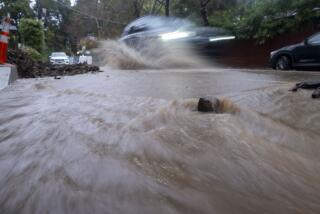Southland Braces for a New Soaking
- Share via
Muddied but unbowed, a rain-soaked Southland braced itself Monday for yet another winter storm, this one expected to dump as much as three inches of rain in some areas by midweek.
Meteorologists predicted that the latest storm system will hit Los Angeles this evening, producing more showers and thunderstorms as it moves in from the west and heightening the risk of major mudslides now and in the months to come.
“With these storms, we’ll be getting some pretty intense rain showers because they’re picking up a lot of subtropical moisture,” said Gary Neumann, a meteorologist with the National Weather Service.
“That’s likely to give us some local flooding and mudslides because the ground is already fairly saturated” from the weekend.
In Orange County, Laguna Canyon Road remained closed Monday, flooded with three days of rain that left parts of the thoroughfare under as much as four feet of water.
And in Topanga Canyon, Caltrans closed Topanga Canyon Boulevard between Old Topanga Road and Mulholland Highway on Monday. Southbound motorists were detoured at Mulholland Drive, while northbound traffic detoured to Old Topanga Road. The road was closed to everyone except residents while crews attempted to repair a ruptured drain pipe and eight-inch-deep potholes before the rains began.
Engineers warned that the storms could bring problems through the end of the year, as seeping rainfall penetrates the upper layers of soil and undermines the compacted earth beneath.
“When we only get four to six inches of rain a year, the landslides don’t seem to happen,” said Ronald Scott, a Caltech engineering professor. But in periods of heavy rainfall, Scott said the critical mass seems to be more than 10 inches in three or four months--the bedrock becomes weakened and landslides occur when the rains begin the next autumn.
Particularly vulnerable, Scott said, are the coastal areas, such as Pacific Palisades, Palos Verdes, Laguna Beach and the Malibu coast, where the underlying bedrock is made mostly of compacted soil rather than granite.
Also at risk, he said, are areas where the topography has changed in the recent drought-parched years.
“In Southern California, we get very little rain for five or six years, and in that time all sorts of changes take place--highways are cut, hills are graded, new construction occurs--and none of it ever gets wet,” Scott said.
“There are a whole lot of slopes out there just waiting to fail that were not there the last time around,” he said.
The weekend storm, which moved out of the Los Angeles Basin by Monday afternoon, dropped about two inches of rain on Southern California, bringing the season total at the Los Angeles Civic Center to more than 20 inches and marking this as the wettest rainy season in nearly a decade.
According to the National Weather Service, the last time rainfall at the Civic Center cracked the 20-inch mark was in 1983, when the precipitation was 31.28 inches.
Forecasters say there is little chance that the rain is over.
The storm moving in from the Pacific is expected to hit sometime after 6 p.m., with rainfall averaging from about an inch in the coastal areas up to about three inches in the mountains, said Rick Dittmann, meteorologist with WeatherData Inc., which provides forecasts for The Times.
The National Weather Service predicts that snow levels will be down to about 6,000 feet, with additional snowfall of six to 10 inches in the resort areas.
Saturating the Soil
Heavy rains can cause street flooding and minor mudslides, but a longer-term problem occurs when the soil gets over-saturated. Here is a look at what can happen during the rain season from December through March:
A) When rainfall is less than about 4 to 6 inches, there tend to be few problems.
B) When rainfall approaches 6 to 10 inches, soil begins to saturate and water becomes harder to absorb. Small mudslides, with a few feet of soil washing away, can occur.
C) With more than 10 inches, real problems begin. These include large mudslides during the storms and, later in the year, the chance of massive landslides as water undermines bedrock layers of compacted earth.
The Worst Case
The major long-term risk of saturated soil is that it will be weakened and later give way.
* In some areas of the Southland--especially in coastal places including Pacific Palisades, the Malibu Coast, Palos Verdes and Laguna Beach--the underlying bedrock is not the usual granite but compacted earth.
* Heavy rainfall during the winter months can seep into this less-stable type of bedrock.
* The seepage can loosen the soil.
* In the fall, minor rains can make the weakened area vulnerable to a big slide.
Source: Caltech
More to Read
Sign up for Essential California
The most important California stories and recommendations in your inbox every morning.
You may occasionally receive promotional content from the Los Angeles Times.











